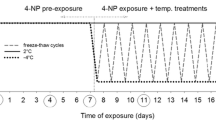Abstract
Panagrolaimus davidi is a freeze-tolerant Antarctic nematode which survives extensive intracellular freezing. This paper describes the development of culture techniques which provide clean samples, with a high degree of freeze tolerance and in sufficient quantities for the analysis of potential cryoprotectants. Cultures grown at 20 °C survived a short-term freezing stress but survival declined with the time spent frozen. Acclimation of cultures at 5 °C enhanced the long-term survival of freezing. Starvation, however, reduced the nematode's ability to survive short-term freezing. The principal cryoprotectants detected by gas chromatography were trehalose and glycerol. The levels of trehalose, but not those of glycerol, increased significantly after acclimation. Trehalose may stabilise membranes and protect them against the dehydrating effects of the osmotic stresses resulting from freeze concentration effects but other factors, such as recrystallisation inhibition, may be involved in long-term survival.
Similar content being viewed by others
Author information
Authors and Affiliations
Additional information
Accepted: 7 March 2000
Rights and permissions
About this article
Cite this article
Wharton, D., Judge, K. & Worland, M. Cold acclimation and cryoprotectants in a freeze-tolerant Antarctic nematode, Panagrolaimus davidi . J Comp Physiol B 170, 321–327 (2000). https://doi.org/10.1007/s003600000106
Issue Date:
DOI: https://doi.org/10.1007/s003600000106




